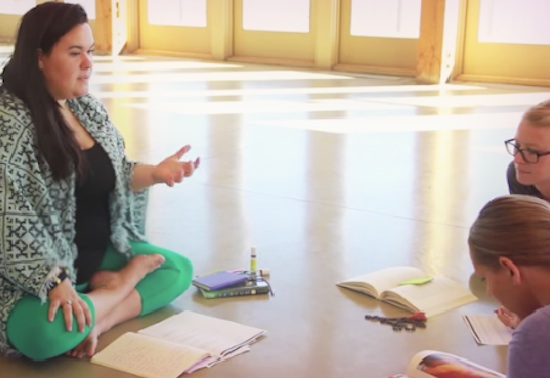
In our modern yoga society, group-led yoga classes are often the most accessible pathway yogis have to our beloved practice.
It’s incredible to think that the way yoga was first delivered (directly from teacher to student) isn’t the way that most modern yogis comes to the mat.
Instead of 1:1 work being the standard, group classes are the entry point for many yoga practitioners.
Most private yoga teachers start teaching group classes or continue to teach them as a way to connect and work with students in a group setting until the relationships they’ve established evolve into one-on-one sessions.
Here is some insight to guide yogis in teaching to the individual, even in a group setting:
Container for Change
Show up to teach group classes with the intention of moving your students toward change. If it requires you to teach less in order to focus on a few really well—make that shift. If you need more inspiration or education—prioritize that. And make your personal practice a priority so you stay connected to your “why” as a teacher.
Sequencing to the Individual
It’s not easy to address the needs of many at once as we set out to do in a group setting, but it’s possible.
Emphasizing each individual’s experience in a group-led classes can be achieved through sound sequencing and giving a range of options that allow each student to inform their own practice. You can’t teach 100 percent to what each yogi needs in a group setting, but you can get really close by developing the skill of teaching many individually, at once.
In an effort to get group-led practitioners ready for one-on-one sessions, focus on encouraging self-practitioners, make it a priority to teach modifications, harmonics and versions, and don’t be attached to conventional group teaching—consider reinventing the way you teach small and large groups of yogis.
Understand (and solve) pain points
Over time you will develop an understanding of who your ideal client is (we call this our perfect-fit private client or our dream client). Crafting and identifying your dream client will turn up a lot of insight into what you should be teaching that type of student. As you get to know your ideal students you’ll identify their frustrations, problems, and pain points. Understanding these general pain points means you can cater your group classes to addressing these problems. Understanding their problems and presenting a solution means you are giving them instant answers and creating the start of a trusting relationship in a group dynamic.
Don’t copycat
Stop worrying about what other yoga teachers are doing in a group setting and stop emulating other teacher’s technique, mannerisms and cues. As green teachers it can be tempting to fake it ‘til we make it—but that’s not what I’m referring to here. When you copycat what you hear elsewhere you adopt someone else’s intentions and likely they are not in line with your own.
For everything you do in your yoga teaching you should have a reason. If you don’t know the reason or the answer it’s not yet time for you to share it.
Be present
Practice the art of being fully present in your group classes.
As a yoga teacher, it can be easier to hide behind an template sequence you have burned into your brain or find yourself cueing on auto-pilot throughout an entire group class. Don’t let this happen. Being completely present in your group classes is the first step to being present for your one-on-one students—an act that is palpable and transformational for student and teacher, alike.
A teacher who is checked out can’t connect, offer enhancements that are truly valuable like adjusts and assists and variations, and can miss the opportunity to plant a seed.
Relationships And Reinvention Not Rotations
Speaking of the modern incarnation of yoga, have you noticed that the environment of a yoga studio or a “traditional” group class isn’t as conducive to building meaningful relationships? I sure have. I made a decision years ago to stop teaching revolving group classes. Instead, I lead series based classes that are focused on two things:
1. Solving a problem for a certain type of yoga student (this is my niche/dream client/specialty).
2. Building long-term relationships where I get to know the students and their practice due to the anatomy of the course or series (6 or 8 week series—same place, night, time).
Reinventing the status quo of group classes can look like running laser focused series, offering a hybrid of a guided self-practice (think Mysore but less fixed sequence and more customized to the individual), or small therapeutic group offerings.
Being an innovator when it comes to group classes as a tool for making more impact carves out your spot as a skilled private yoga teacher and yoga expert.
Relephant Read:
The New Teacher’s Guide to Teaching Yoga.
Author: Kate Connell
Editor: Emily Bartran
Photo: Author’s Own






Read 0 comments and reply